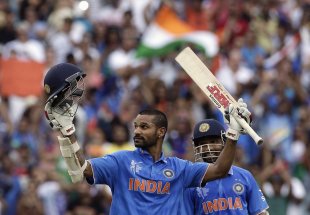World Cup — Shikhar Dhawan smashes 137. Ravi Ashwin takes three wickets. India win by 130 runs at the Melbourne Cricket Ground.
 |
| Dhoni runs out Miller in Melbourne. |
India showed just why no one was writing them off even after they had spent two-and-a-half months in Australia without a win. They might not be the strongest team in the field, but on big days in limited-overs cricket they stay calmer than most. In a match to potentially decide who finishes top of their group, India sat back and saw South Africa work themselves up into a frenzy, get too funky and wilt under the weight of their own mistakes. This was India's first win over South Africa in a World Cup match.
If at all, India like going old school on big days. Shikhar Dhawan and Virat Kohli began slowly, made sure India had a solid platform before they began to accelerate. Dhawan went on to score his first century in three months spent in Australia - his personal best and also the highest score against South Africa in a World Cup match. Kohli fell for 46, but Ajinkya Rahane scored 79 off 60 to help Dhawan along. India kept the defence simple too: bowl as few bad balls as possible, and once again under pressure South Africa imploded.
The execution of both the plans from India was spot on, but that had a lot to do with how simple the plans and preparation were. South Africa called in Gary Kirsten and Michael Hussey for consultation, they picked an extra bowler in Wayne Parnell, they used spinners in unconventional parts of the innings, but the anxiety showed the most in the fielding. Hashim Amla dropped Dhawan on 53, but anxiety was never more apparent in their trigger-happiness with unnecessary throws at the stumps and fumbles on the ground. It's hard to remember when South Africa last fielded so badly.
It started much better, though. AB de Villierssent Rohit Sharma back for a duck with a direct hit from extra cover. India deserve all the credit for not panicking when Dale Steyn was bowling well along with Vernon Philander. It took them 14 overs to reach four an over for the first time, but South Africa looked the more anxious team. Philander had walked off with a hamstring injury, Morne Morkel had begun ordinarily, and Parnell - who would register the worst figures for a South African in a World Cup match - was going to be targeted.
Dhawan and Kohli attacked South Africa with proper attacking shots, and not scoops and reverses. They added 127 in 24.2 overs with Kohli taking the back seat to Dhawan's positive approach. It could have gone better for South Africa. Dhawan had looked in good touch in reaching 53 off 73, Kohli had just about got over a slow start, but South Africa were offered an opportunity to halt the assault. Dhawan cut Parnell to the right of Amla at point, a regulation catch by modern standards, Amla got both hands to it, but dropped it.
Before the match Kohli had spoken about sustained momentum and not relying just on the final 10 overs. Dhawan and he then walked the talk, taking 53 off the next seven overs. Parnell was their main target but even the return of Steyn didn't slow India down. Nor did the fall of Kohli - against the run of play and to a long hop from Tahir - slow them down. Rahane and Dhawan flowed smoothly, building up to a crescendo towards the Powerplay, which brought them 44 runs with no loss of wicket. Rahane and Dhawan added 125 in 16.3 overs.
In the final few overs, though, despite some more ordinary fielding, South Africa managed to pull India back a little. Only 80 came off the last 10, but India had a testing total on the board. South Africa don't have much batting after No. 6 but their top six are as good as any. There is a reason, though, why they have now failed to chase 270 eight times out of nine since they beat India in Nagpur in 2011. There is credit in how they have conceded 270 only nine times, but under pressure their batting invariably falters.
Once again India made sure they didn't make mistakes. South Africa's arrived shortly. There was hardly a bad ball bowled in the first three overs, and Quinton de Kock went manufacturing something in the fourth, driving Mohammed Shami straight to mid-off with the ball nowhere near driving length. Amla was handcuffed by the lack of easy boundaries before he top-edged a hook. The much-maligned bowling was doing the job for India once the batsmen had put runs on the board.
At 40 for 2, Faf du Plessis and de Villiers came together. They added 68 for the third wicket, but they had to earn every run. India hustled in the field and bustled with the ball. There was no freebie on offer. With the asking rate rising, every set of two-three dot balls imparted pressure. De Villiers' response to four straight dots in the 23rd over was to risk an improbable second, but India's fielding today gave away nothing. Mohit Sharma swooped in from deep cover, and threw right by the stumps. The asking rate was now close to 7.5, and South Africa now needed a miracle.
Miracles rarely happen in such high-profile clashes once you have put yourself under so much pressure. Wickets kept falling as South Africa looked to manufacture runs, and India's reputation of good players of big matches in limited-overs cricket enhanced even further. They were now all but sure to face in quarter-final the fourth-placed team from the other group.

Comments
Post a Comment